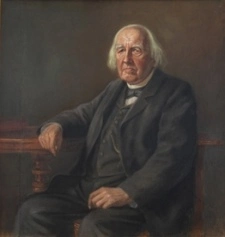Global Extrema of Functions
Definition of Global Maximum and Global Minimum
Consider a function y = f (x), which is supposed to be continuous on a closed interval [a, b]. If there exists a point x0 ∈ [a, b] such that f (x) ≤ f (x0) for all x ∈ [a, b], then we say that the function f (x) attains at x0 the maximum (greatest) value over the interval [a, b].
The greatest value of the function f (x) on the interval [a, b] is simultaneously the least upper bound of the range of the function on this interval and is denoted as
Similarly, if there exists a point x0 ∈ [a, b] such that f (x) ≥ f (x0) for all x ∈ [a, b], then we say that the function f (x) attains at x0 the minimum (least) value over the interval [a, b].
The least value of the function \(f\left( x \right)\) on the interval \(\left[ {a,b} \right]\) is simultaneously the greatest lower bound of the range of the function on this interval and can be written as
These concepts characterize the behavior of a function on a finite interval, in contrast to the local extremum, which describes the properties of the function in a small neighborhood of a point. Therefore, the maximum and minimum values of a function on an interval are often referred as the global (absolute) maximum or, respectively, the global minimum.
The Weierstrass Extreme Value Theorem
According to the Weierstrass extreme value theorem for continuous functions, if a function \(f\left( x \right)\) is continuous on a closed interval \(\left[ {a,b} \right],\) then it attains the least upper and greatest lower bounds on this interval.

The proof of this theorem is based on the Weierstrass boundedness theorem, which is stated as follows:
If a function \(f\left( x \right)\) is continuous on the interval \(\left[ {a,b} \right],\) then it is bounded on it, i.e. there exists a real number \(M\) such that \(\left| {f\left( x \right)} \right| \le M\) for all \(x \in \left[ {a,b} \right].\)
Returning to the extreme value theorem, we denote by \(M\) the least upper bound of the range of the function (or the maximum value of the function) on the interval \(\left[ {a,b} \right].\) Assume the contrary, that the least upper bound is not attained, i.e. assume that
Consider the auxiliary function:
Since the denominator is not zero, then the function \(\varphi \left( x \right)\) is also continuous on \(\left[ {a,b} \right]\) and hence, by the boundedness theorem, it is bounded on this interval: \(\varphi \left( x \right) \le L,\) where \(L \gt 0.\) It follows from here that
In other words, the number \(M - {\frac{1}{L}}\) will be the least upper bound of the function \(f\left( x \right)\), which contradicts the condition. (By the condition, the least upper bound of the function is equal to \(\left.{M}\right).\)
In the same way we can prove that a function \(f\left( x \right)\) that is continuous in a closed interval \(\left[ {a,b} \right]\) attains in this interval its greatest lower bound (or the minimum value).
Thus, according to the extreme value theorem, a function that is continuous on an interval always attains its maximum and minimum values on this interval.
Finding the Maximum and Minimum Values of a Function
Let a function \(y = f\left( x \right)\) be continuous on an interval \(\left[ {a,b} \right].\)
If the function on this interval has local maxima at the points \({x_1},{x_2}, \ldots ,{x_n},\) then the maximum value of the function \(f\left( x \right)\) on the interval \(\left[ {a,b} \right]\) is equal to the greatest of the numbers
Similarly, if the function on this interval has local minima at the points \({{\bar x}_1},{{\bar x}_2}, \ldots ,{{\bar x}_k},\) then the minimum value of the function \(f\left( x \right)\) on \(\left[ {a,b} \right]\) is equal to the least of the numbers
Thus, the global maximum (minimum) values of a function are attained either on the boundary of the interval (Figure \(2\)), or at the points of local extrema inside the interval (Figure \(3\)).
Special Case 1
If there exists a unique extremum point \({x_1}\) inside the interval \(\left[ {a,b} \right]\) and this point is the local maximum (minimum), then the function attains the global maximum (minimum) at this point (Figure \(4\)).
Special Case 2
If the function \(y = f\left( x \right)\) has no critical points on the interval \(\left[ {a,b} \right],\) then the function has the global minimum at one endpoint of the interval and the global maximum on the other endpoint (Figure \(5\text{).}\)
Special Case 3
In practice, there are often cases when a differentiable and positively defined function \(f\left( x \right) \gt 0\) is given on an interval \(\left[ {a,b} \right]\) and is equal to zero at the endpoints of the interval: \(f\left( a \right) = f\left( b \right) = 0.\) If this function has a unique stationary point \({x_1}\) (where \(f'\left( {{x_1}} \right) = 0\)), then this point is not only the local maximum of the function, but also its global maximum on the interval \(\left[ {a,b} \right]\) (see Figure \(6\)).